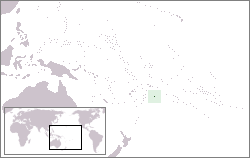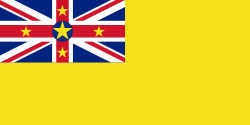Niue
| |||

| |||
| Official languages | Niuean, English | ||
| Capital | Alofi | ||
| Head of State | Elizabeth II of the United Kingdom | ||
| New Zealand High Commissioner |
Anton Ojala | ||
| Premier | Young Vivian | ||
| Area – Total – % water |
260km² 0 | ||
| Population – Total (2005) |
1,445 | ||
| Establishment – Date |
Niue Constitution Act 1974 | ||
| Currency | New Zealand dollar | ||
| Time zone | universal time -11 | ||
| National anthem | Ko e Iki he Lagi | ||
| Calling Code | 683 | ||
| Internet TLD | .nu | ||
| 296px | |||
| Map of Niue | |||
Niue is an island nation] located in the South Pacific Ocean. It is commonly known as "Rock of Polynesia". Although it is self-governing, it is in free association with New Zealand. This means that the sovereign in right of New Zealand is also the head of state of Niue, and most diplomatic relations are conducted by New Zealand on Niue's behalf. Niue is located 2400km north-east of New Zealand in a triangle between Tonga, Samoa and the Cook Islands.
Geography
Niue is a 260 square kilometer island, about 1.5 times the size of Washington,DC. There are three outlying coral reefs, that do not have any land area: Beveridge Reef, located 300km south-east, is a submerged atoll drying during low tide, 9.5km from north to south and 7.5km east-west. It has no land area, and has a lagoon 11 meters deep. Antiope Reef, located 193km south-east, is a circular plateau approximately 400 meters in diameter. Haran Reef is located at 21°33'S, 168°55'W.
Niue is one of the world's largest coral islands. The terrain consists of steep limestone cliffs along the coast with a central plateau rising to about 60 meters above sea level. A coral reef surrounds the island, with the only major break in the reef being on the central western coast, close to the capital, Alofi. A notable feature of the island is the number of limestone caves found close to the coast.
The island is roughly oval in shape and has a diameter of about 18km, with two large bays indenting the western coast (Alofi Bay in the centre, and Avatele Bay in the south). Most of the island's population reside close to the west coast, around the capital and in the northwest.
The island has a tropical climate, modified by southeast trade winds, with most rainfall occurring between November and April. Natural resources include fish, and arable land. Forests and woodland make up 19 percent of Niue, arable land 19 percent, permanent crops 8 percent, permanent pastures 4 percent, and "other" makes up 50 percent.
Typhoons pose the main natural hazard. There increasing attention to conservationist practices to counter loss of soil fertility from traditional slash and burn agriculture
History
Niue's remoteness, as well as cultural and linguistic differences between its Polynesian inhabitants and those of the rest of the Cook Islands, have caused it to be separately administered. The population of the island continues to drop (from a peak of 5200 in 1966 to 2100 in 2000) with substantial emigration to New Zealand.
Niue was first settled by Polynesian sailors from Tonga, Samoa, and the Cook Islands. Captain James Cook was the first European to sight the island, but he was unable to land there due to fierce opposition by the local population. In response, he named Niue the Savage Island.
Christian missionaries from the London Missionary Society converted most of the population around 1846. In 1887, King Fataaiki wrote to Queen Victoria of England, requesting that Niue be placed under British protection, but his request was turned down. In 1900, in response to renewed requests, the island became a British protectorate, and the following year it was annexed by New Zealand. Niue gained its autonomy in 1974 in free association with New Zealand, which handles the island's military and foreign affairs. Niue had been offered autonomy in 1965 (along with the Cook Islands, which accepted), but had asked for its autonomy to be defered another decade.
In January of 2004, Niue was struck by a devastating cyclone (Cyclone Heta) which killed two people and left 200 of the islands' 1600 inhabitants homeless. A number of local residents chose afterwards not to rebuild.
Politics
The Niue Constitution Act 1974 (NZ) vests executive authority in Her Majesty the Queen in Right of New Zealand and the Governor-General of New Zealand. The constitution specifies that in everyday practice, it is exercised by a Cabinet of the Premier of Niue and three other ministers. The premier and ministers must be members of the Niue Assembly, the nation's legislative assembly.
The assembly consists of 20 democratically elected members, fourteen by the electors of village constituencies. The remaining six are elected the same way, except several constituencies are combined for each seat. Electors must be New Zealand citizens, resident for at least three months, and candidates must have been electors, resident for twelve months. The speaker is elected from among the members.
Niue has been self-governing in free association with New Zealand since 1974. Niue is fully responsible for internal affairs. New Zealand retains responsibility for foreign affairs and defense. However, these responsibilities confer no rights of control and are only exercised at the request of the Government of Niue. Niue has no regular indigenous military forces.
Economy
Niue's economy is very small with a GDP of around $US7.6-million estimated in 2000. Most economic activity centres around government and work on family plantations. It uses the New Zealand dollar and relies on New Zealand aid to sustain its government.
The economy suffers from the Pacific island problems of geographic isolation, few resources, and a small population. Government expenditures regularly exceed revenues, and the shortfall is made up by grants from New Zealand to pay wages to public employees. Niue has cut government expenditures by reducing the public service by almost half. The agricultural sector consists mainly of subsistence gardening, although some cash crops are grown for export. Industry consists primarily of small factories to process passion fruit, lime oil, honey, and coconut cream.
Export commodities include canned coconut cream, copra, honey, vanilla, passion fruit products, pawpaws, root crops, limes, footballs, stamps, and handicrafts. Exports totalled $US137,200 in 1999. Export partners in 2004 were New Zealand mainly, Fiji, Cook Islands, and Australia.
Import commodities included food, live animals, manufactured goods, machinery, fuels, lubricants, chemicals, and drugs. Imports totalled $US2.38-million in 1999. Import partners were New Zealand mainly, Fiji, Japan, Samoa, Australia, and the United States.
In August 2005, Australian mining company Yamarna Goldfields suggested that Niue might have the world's largest deposit of uranium. It has permission to drill on the island to confirm geological data.
Foreign aid, principally from New Zealand, has been the island's principal source of income. Tourism generates some revenue but there is very little industry on the island. Remittances from Niuean expatriates generally from New Zealand constitute a significant proportion of Niue's income as well.
The government generates some limited income also from the sale of its postage stamps to foreign collectors and domain names, with its top level domain .nu. The Government briefly flirted with the creation of "offshore banking" but under pressure from New Zealand agreed to end its support for schemes designed to minimise tax in countries like New Zealand.
Niue's economy suffered from the devastating tropical cyclone of 2002.
Demographics
Population: 1,600 (2004 est.)
Age structure:
0-14 years:
29.70%
15-64 years:
61.20%
65 years and over:
9.10%
Population growth rate: 0.47% (2000 est.)
Birth rate: 18.46 births/1,000 population
Death rate: 7.80 deaths/1,000 population
Net migration rate: NA migrant(s)/1,000 population
Infant mortality rate: 29.4 deaths/1,000 live births
Life expectancy at birth:
total population:
70.10 years
male:
69.80 years
female:
71.20 years
Total fertility rate: 3.01 children born/woman
Nationality:
noun:
Niuean(s)
adjective:
Niuean
Ethnic groups: Polynesian (with some 200 Europeans, Samoans, and Tongans)
Religions: Ekalesia Niue (Niuean Church - a Protestant church closely related to the London Missionary Society) 75%, Church of Jesus Christ of Latter-Day Saints 10%, other 15% (mostly Roman Catholic, Jehovah's Witnesses, Seventh-day Adventist)
Languages: Polynesian closely related to Tongan and Samoan, English
Literacy:
definition:
NA
total population:
95%
male:
NA%
female:
NA%
Society and culture
Niue is a Polynesian island in the South Pacific. Though independent, it is in free association with New Zealand. Manaia Studio is the only recording studio on the island. The musician Che Fu is very popular, and has won several Tui Awards, a New Zealand music award. Church choirs are also common.
See also
- Communications in Niue
- Transportation in Niue
External links
- The Official Website of the People of Niue
- Electionworld file on Niue
- History of Niue
- Internet Users Society Niue site
- Map of Niue
- Niuean Government site
- Niue National Telecommunications Policy 2003
- .nu domain name registry site
- Register article which mentions the impact of the cyclone
- World Factbook entry on Niue
- Environment Department
- InvestNiue
- Niue Business News
- Statistics Niue
- Niue Tourism
Template:New Zealand Template:Polynesia Template:Pacific Islands
Credits
New World Encyclopedia writers and editors rewrote and completed the Wikipedia article in accordance with New World Encyclopedia standards. This article abides by terms of the Creative Commons CC-by-sa 3.0 License (CC-by-sa), which may be used and disseminated with proper attribution. Credit is due under the terms of this license that can reference both the New World Encyclopedia contributors and the selfless volunteer contributors of the Wikimedia Foundation. To cite this article click here for a list of acceptable citing formats.The history of earlier contributions by wikipedians is accessible to researchers here:
The history of this article since it was imported to New World Encyclopedia:
Note: Some restrictions may apply to use of individual images which are separately licensed.
